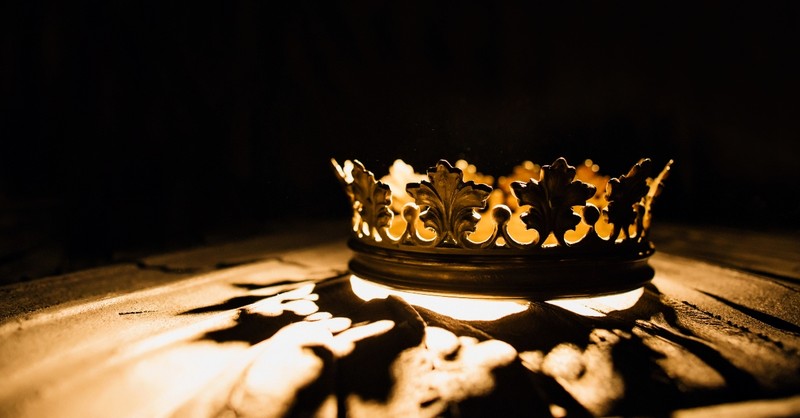There is a heaven, and we can look forward to it! We often consider heaven only when someone is dying. But the kingdom of heaven is meant to be not only a promised future but motivation and refreshment to inspire us now. Singing hymns about heaven is one way to meditate on all God has promised and all we gain by persevering in Christ.
Peter and the first Christians faced intense persecution and trial. Peter found encouragement and strength by considering what awaits us in glory. “Blessed be the God and Father of our Lord Jesus Christ! According to his great mercy, he has caused us to be born again to a living hope through the resurrection of Jesus Christ from the dead, to an inheritance that is imperishable, undefiled, and unfading, kept in heaven for you” (1 Peter 1:3-4 ESV). Our future is secure so that we can live boldly and sacrificially now.
An unfortunate phrase is that someone is “so heavenly minded they’re no earthly good.” Reject that thinking! Of course, we don’t sit staring at the sky, waiting for Jesus to return. But, keeping heaven in our thoughts and meditating on all that awaits us fortifies us for the work God has here. Like the promise of water at the end of a long desert or the reward of a great feast after the harvest, the hope of heaven keeps our feet on the narrow road and our eyes on the Lord despite every trial.
Photo credit: ©Getty Images/Romonolo Tavani

1. Blessed Assurance
Fanny Crosby was a 19th-century mission worker and poet who wrote over 8,000 hymns. “Blessed Assurance” doesn’t mention heaven by name. Still, the spirit of the hymn captures what looking toward heaven does to engage our hearts now as we labor on earth and long for what is to come.
“Blessed assurance, Jesus is mine! O, what a foretaste of glory divine!” Here, we remember that we belong to Jesus. That understanding provides a foretaste of eternity.
“Perfect submission, perfect delight! Visions of rapture now burst on my sight; angels descending bring from above, echoes of mercy, whispers of love.” This second stanza captures the interplay between the worshipper and the ministry of angels, assuring us there is more happening than we can see. It is reminiscent of Jacob’s ladder and John’s glimpse into heaven recorded in Revelation.
The joy delivered by these angelic messengers rings out in the chorus, “This is my story, this is my song, praising my Savior all the day long!” The exuberance expresses the release we feel when, amid trials, we connect with the hope of heaven.
Crosby was blind from infancy, but her spiritual eyes were open and ready to express the joy and truth of what she saw through life in Christ. She powerfully expresses the vision of our souls in her final verse, “Watching and waiting, looking above, filled with His goodness, lost in His love.” May we all see as clearly as her!
Blessed Assurance from fpcbabylon on GodTube.
Image Source: ©GettyImages/Ig0rZh

2. A Child of the King
Harriet “Hattie” Buell was walking home from a Sunday morning service at her Methodist church in Manlius, New York, when the words to this hymn came to her. She submitted them as a poem to The Northern Christian Advocate magazine, and they were set to music by John. B. Sumner.
The words speak a simple but powerful message that while we may have humble circumstances on this earth, we are children of a great king.
“My Father is rich in houses and lands; He holdeth the wealth of the world in His hands.” In verse one, Hattie describes the richness of our Heavenly Father and concludes with the chorus declaring, “With Jesus, my Savior, I’m a child of the King.”
In verse two, Harriet talks about God sending His own Son to wander the earth “as the poorest of them. But now He is reigning forever on high and will give me a home in heav’n by and by.” So powerful to remind the singer of Jesus’ humble means. God sent His own Son into a simple life on earth, but because of Him, we will one day be with Him in Heaven.
Verse three describes the singer as once “an outcast stranger on earth.” But now, because of Jesus, she is “an heir to a mansion, a robe, and a crown.”
Finally, verse four sails with the words, “A tent or a cottage, why should I care? They’re building a palace for me over there.” The promise of heaven can truly strengthen the humblest of us.
Photo Credit: © iStock/Getty Images Plus/Yurii Kifor

3. When We All Get to Heaven
There is a theme of women hymnists penning classic hymns about heaven, and it continues with this one.
Not only was this written by a woman, Philadelphian Eliza Hewitt, but the music was composed by Emily Wilson. This hymn captures the feeling of old-time camp meetings and the revivals that followed the Second Great Awakening. Eliza was a close friend of Fanny Crosby and suffered from a spinal ailment. Still, she had a teacher’s heart, and a love for God appears clearly in her writing. No melancholy, gaze-at-the-sky reflection on our destiny, this hymn is a spirited reminder to rejoice, believing in what lies ahead.
“Sing the wondrous love of Jesus, sing His mercy and His grace; in the mansions bright and blessed He’ll prepare for us a place.” This is line is Inspired by John 14:2, “In my Father’s house are many rooms. If it were not so, would I have told you that I go to prepare a place for you?” Hewitt takes to heart the command in verse 1 to not let our hearts be troubled! God invites her to believe, and she does brilliantly with this hymn.
The chorus is filled with exciting musical echoes that would have made it a favorite with young believers. “When we all get to heaven, what a day of rejoicing that will be! When we all see Jesus, we’ll sing and shout the victory!”
The final verse nods to traditional images of heaven glimpsed at the end of Revelation, “Soon the pearly gates will open, we shall tread the streets of gold!”
Terry Blackwood and Karen Peck - When We All Get to Heaven from bill-and-gloria-gaither on GodTube.
Photo Credit: © Getty Images/Yuri_Arcurs

4. Rock of Ages
From the camp meetings of Philadelphia to the high church of England, hymns about heaven inspire all. Augustus Montague Toplady, reformed Anglican minister, penned this contemplative and sober hymn about passing from this life to the next.
Many old hymns use plural pronouns, but this one appropriately uses the very personal “I” and “me.” We all travel from this life to the next as individual souls in need of personal salvation.
There is an unverified story: Toplady composed the hymn while trapped in a storm, taking shelter in a gap in a rock, reminiscent of Elijah taking shelter in a cave when the Lord “passed by.”
“Then a great and powerful wind tore the mountains apart and shattered the rocks before the Lord, but the Lord was not in the wind. After the wind there was an earthquake, but the Lord was not in the earthquake. After the earthquake came a fire, but the Lord was not in the fire. And after the fire came a gentle whisper. When Elijah heard it, he pulled his cloak over his face and went out and stood at the mouth of the cave” (1 Kings 19:11-13a NIV).
The pull toward heaven is heard most keenly in the third verse. “While I draw this fleeting breath, when my eyes shall close in death, when I rise to worlds unknown and behold Thee on Thy throne, Rock of Ages, cleft for me, let me hide myself in Thee.” In life and death, our surest refuge is Jesus.
Photo Credit: © Getty Images/bazilfoto

5. O That Will Be Glory
Charles Hutchinson Gabriel grew up on an Iowa farm, eventually settling in Chicago and working in music publishing. Inspired by Ed Card, a minister with the Sunshine Rescue Mission, Gabriel composed this heavenly-minded hymn. Card used to punctuate his sermons with “glory” rather than “amen” and often ended his prayers referencing heaven and the phrase, “that will be glory for me.” Gabriel fashioned his thoughts around that phrase and wrote this hymn around 1900.
The music flows from verse to chorus, like the smooth motion of a merry-go-round. “When all my labors and trials are o’er, and I am safe on that beautiful shore, just to be near the dear Lord I adore will thro’ the ages be glory for me.”
Gabriel equates heaven with seeing Jesus’ face and references friends who will be present on that shore. The piece glides along on lyrics as smooth as the river referenced in verse three “Joy like a river around me will flow, yet, just a smile from my Savior, I know, will thro’ the ages be glory for me. O that will be glory for me, glory for me, glory for me! When by His grace I shall look on His face, that will be glory, be glory for me!”
The theme of laboring hard on earth to be rewarded with heaven and the look on Jesus’ face is intended not to be escapist but motivational. What better way to persist in our labors than to imagine Jesus and our friends waiting to greet us in glory?
Photo Credit: © Getty Images/Margaryta Basarab

6. Faith Is the Victory
Like many others, John Yates tested various professions before he found his calling as a pastor in 1886. John had been a shoe salesman, news editor, and hardware store manager in Batavia, New York. When he was with the newspaper, John wrote the lyrics for “Faith is the Victory.”
Like many of its time, this hymn portrays a militaristic view of the kingdom’s work. The first verse describes believers “encamped along the hills of light, ye Christian soldiers rise and press the battle ere the night shall veil the glowing skies.” It is a rally to all who might linger in their pews, to be about the work of battling for souls.
In verses two and three, Yates references the armor of God listed in Ephesians 6. “Our sword the Word of God.” “The faith by which they conquered death is still our shining shield.” “Salvation’s helmet on each head with truth all girt about.” These announce a bold message of spiritual warfare and triumph.
Of course, we can’t discuss battle without considering the consequence of war. Verse four looks forward to heaven. “To him that overcomes the foe white raiment shall be giv’n; before the angels he shall know His name confessed in heav’n.” This references the rewards for “those who overcome” listed in Revelation.
Yates was a man who embraced God’s Word and sought to inspire others to purpose and action with the promise of heaven for all who overcome.
Photo Credit: © iStock/Getty Images Plus/kieferpix

7. Day by Day
Another hymn about heaven, another female hymn writer. This time, Carolina Sandell-Berg, sometimes known as the “Fanny Crosby of Sweden,” penned a hymn that grounds us in the everyday, yet it leaves us on the shores of the Promised Land.
Tragically, Sandell-Berg wrote this hymn after witnessing her father’s drowning. A Lutheran pastor, the two were particularly close, but he was swept from the deck of a ship during a lake crossing. Lina was already a budding hymn writer, but following the tragedy, she poured her heart into music. These songs were said to have sparked a great revival across Scandinavia.
Verse one speaks beautifully to the trust required to persevere in faith even when we’ve encountered trials of various kinds. “Trusting in my Father’s wise bestowment, I’ve no cause for worry or for fear. He whose heart is kind beyond all measure gives unto each day what He deems best, lovingly its part of pain and pleasure, mingling toil with peace and rest.” How sweetly Sandell-Berg describes the care of a loving Heavenly Father even with days disturbed by great sorrow.
She continues trusting her Heavenly Father with each day, even as they press forward toward death. “Help me, Lord, when toil and trouble meeting, e’er to take as from a Father’s hand, one by one, the days, the moments fleeting, till I reach the Promised Land.” We can feel in this hymn her longing for the father she’s lost, yet the faith in the Father who remains with her and cares for her every moment of every hour.
Photo Credit: © Unsplash/Daiga Ellaby

8. Be Still, My Soul
Katharina Amalia Dorothea von Schlegel is credited as the author of this hymn, but its history spans at least three nations: Germany, Scotland, and Finland. It is initially associated with a 17th-century German revival known as the “revival of Pietism.”
One hundred years later, Jane Borthwick of Scotland translated the original poem into English. The tune is Finlandia, a symphonic tone poem composed by Jean Sibelius in the 1800s. Finally, a Welsh choirmaster married the translated lyrics with the tune, and the church received the magnificence of “Be Still, My Soul.”
Once again, a hymn focuses on the hope of heaven to endure trials on earth. “Be still, my soul! The Lord is on thy side; bear patiently the cross of grief or pain. Leave to thy God to order and provide; in every change, He faithful will remain. Be still, my soul! Thy best, thy heav’nly Friend, thro’ thorny ways leads to a joyful end.”
The final verse leads worshippers to consider how fleeting is our time here. “Be still, my soul! The hour is hast’ning on when we shall be forever with the Lord.” The hymn writer envisions a place where “disappointment, grief, and fear are gone, sorrow forgot, love’s purest joys restored.”
The theme of this hymn is peace, assurance, and faith in the face of uncertainty and change. Like other women hymn writers, Schlegel expresses a longing for eternity. The haunting melody, strengthening lyrics, and international history work together to create a powerful and moving hymn.
Photo Credit: © iStock/Getty Images Plus/PeopleImages

9. In the Sweet By and By
As with John Yates, the author of this hymn explored careers—military and running a drug store—before settling on medicine. Sanford Fillmore Bennett lived in New York in the 1800s. This hymn was a collaboration between Bennett and a musician struggling with depression, Joseph P. Webster.
As Bennett tells it, Webster visited the drug store in one of his blue periods. When Bennett asked what was wrong, Webster replied, “It’s no matter. It will all be right by and by.” In a flash of inspiration, Bennett scribbled the initial words of the hymn, handing them to Webster, encouraging him to compose a tune. Webster immediately set to work with his violin, and within thirty minutes, the two were singing the new piece.
Like others, Bennett looks ahead to the dwelling Jesus promises He is preparing. “There’s a land that is fairer than day, and by faith we can see it afar; for the Father waits over the way to prepare a dwelling place there.” Then, the lilting chorus sounds with these words: “In the sweet by and by, we shall meet on that beautiful shore. In the sweet by and by, we shall meet on that beautiful shore.”
How encouraging a scientist seeking to relieve the emotional burden of a man of music created relief and joy through this hymn. “We shall sing on that beautiful shore the melodious songs of the blest; and our spirits shall sorrow no more, not a sigh for the blessing of rest.” Amen.
Jeff Sheri Easter - In the Sweet By and By [Live] from jeff-sheri-easter on GodTube.
Photo Credit: © GettyImages/Hydromet

10. It Is Well with My Soul
The story behind Horatio Spafford’s moving hymn is well-known. Spafford was a successful Chicago lawyer and landowner blessed in every way. Then, life changed.
Spafford and his wife tragically lost their four-year-old son to scarlet fever. Then the Great Chicago Fire destroyed his properties. Eventually, Horatio sent his wife and daughters on a voyage to Europe, planning to meet them, when the ship struck another and went down. Spafford received a telegram from his wife, saying, “Saved alone. What shall I do?” It was history’s worst naval disaster until the Titanic, with over 226 souls lost at sea.
On Spafford’s crossing to meet his wife, near where all four daughters drowned, he wrote the words that have come to mean so much to so many.
“When peace like a river attendeth my way, when sorrows like sea billows roll; whatever my lot, Thou has taught me to say, ‘It is well, it is well with my soul.’” Spafford had at one time known great peace; but now, in great sorrow, God, and the hope of heaven, are present with him still.
Finally, as his soul must have longed to know Jesus face-to-face and be reunited with his children, Spafford concludes with words that fortify all who continue to sing this hymn:
“And, Lord haste the day when the faith shall be sight, the clouds be rolled back as a scroll, the trump shall resound and the Lord shall descend, ‘Even so’—it is well with my soul.”
Wintley Phipps - It Is Well With My Soul (From Bill Gloria Gaither Live) from bill-and-gloria-gaither on GodTube.
Photo Credit: © Unsplash/Corinne Kutz





.jpg)
